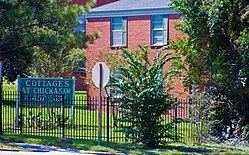Built 1917-1946 Architectural style various Area 4.856 km² | Architect various NRHP Reference # 04000924 Added to NRHP 3 September 2004 | |
 | ||
Chickasaw Shipyard Village Historic District is a historic district comprising buildings and areas within Chickasaw, Alabama, now a northern suburb of Mobile in Mobile County. The site is historically significant due to its role as a company town for the Gulf Shipbuilding Corporation shipyard during the first half of the twentieth century. In addition, the area was the focal point of a United States Supreme Court case concerning First Amendment rights of individuals in privately owned towns. The district was added to the National Register of Historic Places on September 3, 2004.
Contents
Incorporation of Chickasaw
Early in 1946, Leedy Investment Company purchased the entire company town for one million dollars. Current occupants were given the option to purchase the homes they had been renting. Many prior residents also purchased homes and moved back to the town. The city of Chickasaw was incorporated on November 12, 1946. In 1979, Halter Marine reactivated the shipbuilding facility to provide service vessels and tugboats to the booming offshore industry. The resurgence was short-lived and the facility was closed again in 1983. The former shipyard now serves as a small general cargo facility.
Chickasaw Shipyard Village
The company town of Chickasaw was originally owned by Chickasaw Shipbuilding. In addition to well-built and attractive houses, the town included other amenities (a multipurpose community center, a school, a health clinic, and stores) and utility services (a water purification plant, and sewage treatment plant). One exceptionally well-built building originally served as an ice house while later serving as a home to offices and a hospital. Some of the streets in the town were actually sidewalks necessitating use of alleys for vehicular traffic. Tennis courts and a golf course were also available in the town. With the closing of the shipyard of Chickasaw Shipbuilding, many houses were moved or demolished.
Upon the purchase of the shipyard and town by Gulf Shipbuilding in 1940, the existing homes were repaired and modified and additional city improvements (such as street paving) were implemented. The business block was a popular shopping center consisting of numerous buildings connected by a covered concrete sidewalk which ran the length of the block (approximately 250 feet or 75 meters). The establishments included a drugstore, a grocery store, a restaurant, and post office. By 1943, Gulf Shipbuilding had leased the remaining space to other businesses.
Many of the original homes still remain in Chickasaw and form the heart of a historic district. Primarily through the efforts of Gene Ford, an architectural historian from the University of Alabama, this area was added to the National Register of Historic Places in 2004. The Chickasaw Historic Preservation Society has created a driving tour featuring the highlights of the area.
